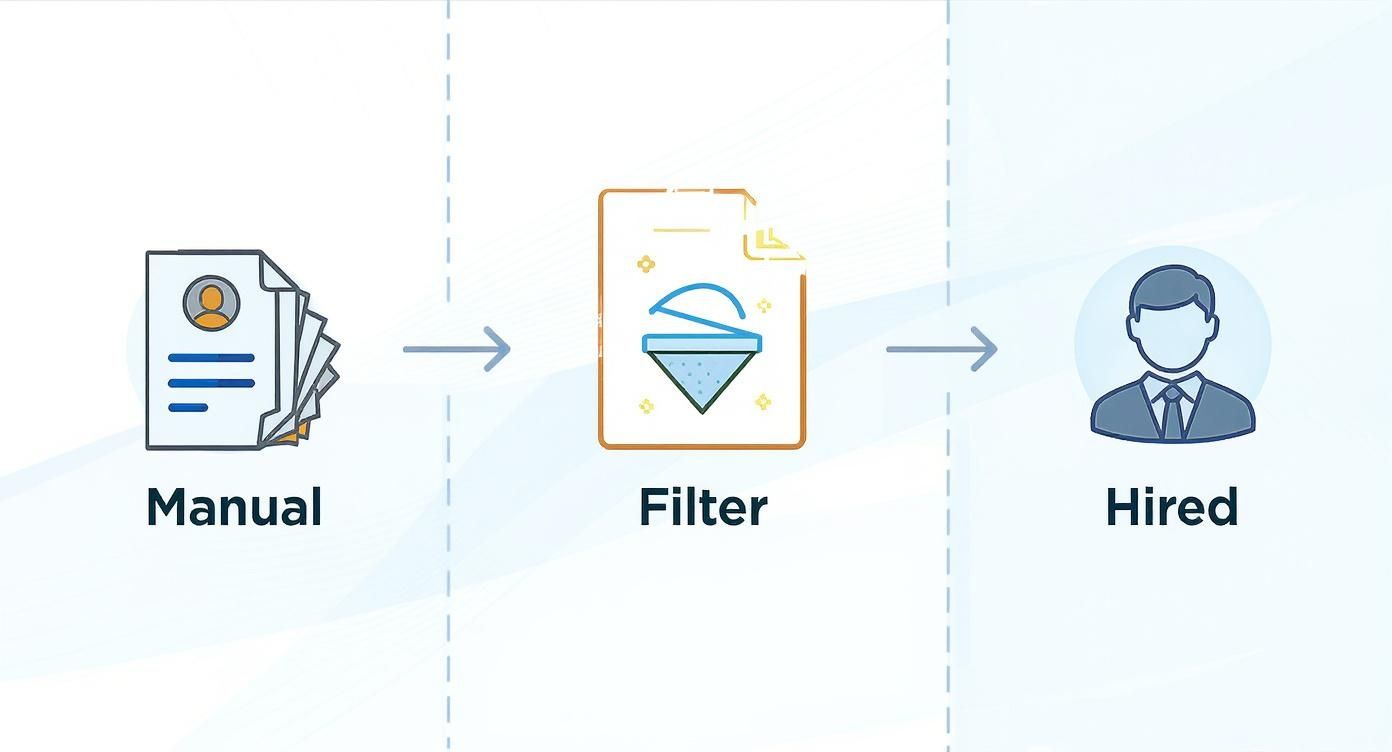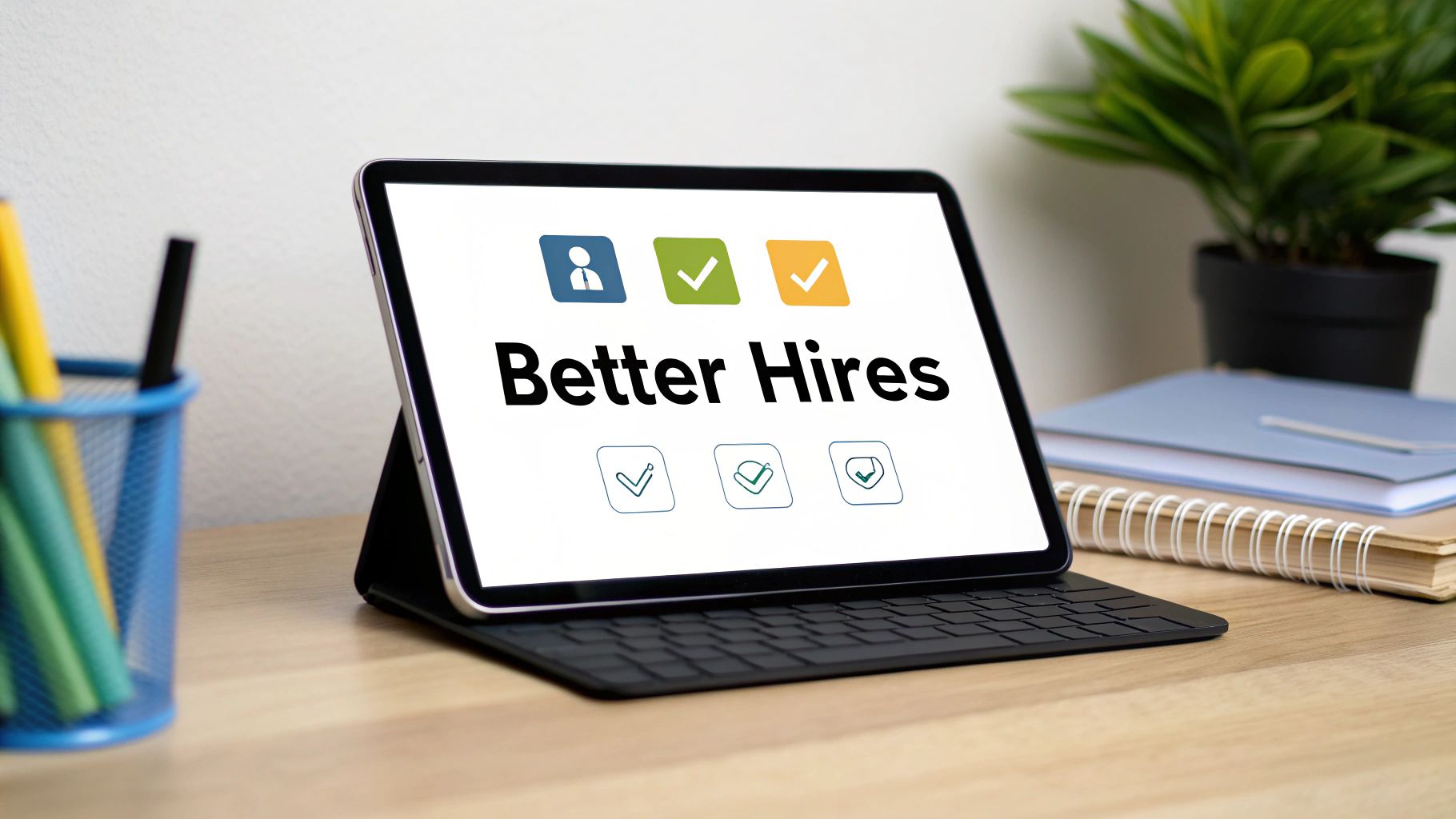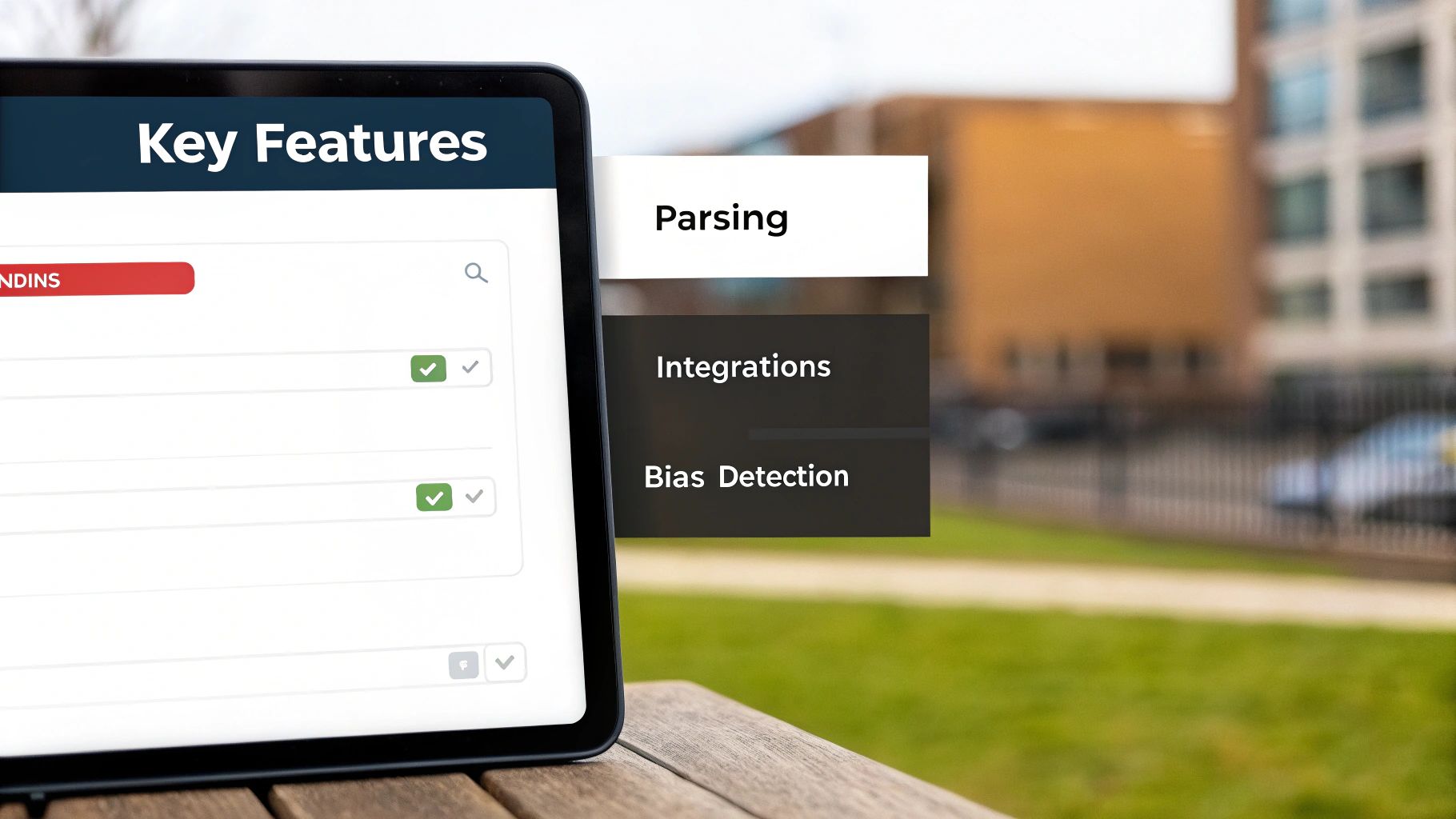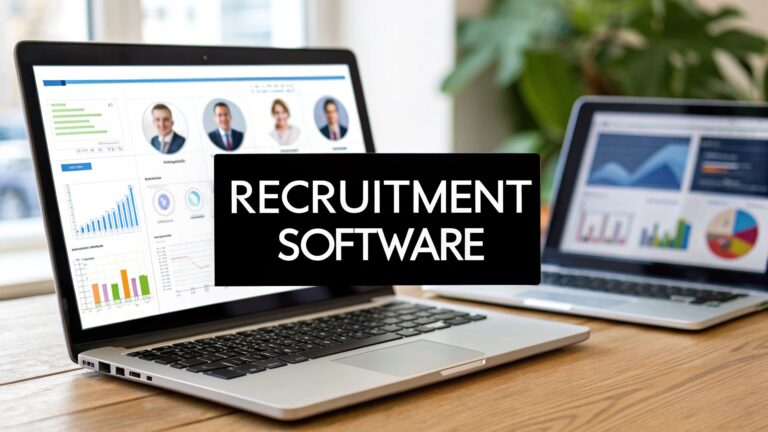Guide to Automated Resume Screening Software
Automated resume screening software is a recruiter's best friend. It’s a tool designed to read, sort, and rank candidates automatically based on their qualifications, acting like a smart assistant that quickly surfaces the best fits from a sea of applicants.
The End of the Resume Pile
Picture a library where thousands of books are just dumped in unsorted piles on the floor, and you have to find one specific title. That's what recruiting often feels like today. For any given job opening, recruiters can get hit with hundreds—sometimes thousands—of applications. It creates a digital mountain of resumes that's simply impossible for a human to get through.
This flood of applications doesn't just slow things down; it breaks the whole hiring process. Great candidates get lost in the noise, recruiters burn out, and hiring timelines stretch from weeks into months. This is exactly the problem that automated resume screening software was created to fix. It’s the digital librarian that brings order to the chaos.
Shifting from Manual to Automated Hiring
Instead of a recruiter spending countless hours poring over every single resume, this software does the initial heavy lifting. It scans for relevant skills, work history, and qualifications, then hands over a neat, organized shortlist of top contenders. This frees up the hiring team to focus on what humans do best: building relationships, conducting great interviews, and making thoughtful hiring decisions.
There's a massive shift happening in how companies hire. A staggering 87% of employers around the world are now using AI in their recruitment, with automated screening at the forefront of this change. After making the switch, companies have reported a 92% reduction in screening time—a number that speaks for itself.
This technology isn't just about moving faster. It's about finding better talent, improving fairness by minimizing unconscious bias, and ultimately building stronger, more diverse teams.
To see how these tools fit into the bigger picture and solve the problem of overwhelming applicant numbers, it's worth exploring the broader world of automated recruitment software. This guide will walk you through everything, from how these systems work under the hood to making the right investment for your company.
How Does Resume Screening Software Actually Work?
Ever felt like you're drowning in a sea of resumes? That's the problem this software was built to solve. Think of it less like a stern gatekeeper and more like a brilliant, incredibly fast assistant. Its main job is to take that chaotic mountain of applications—coming in as PDFs, Word docs, you name it—and neatly organize it into a searchable, easy-to-use database. The whole process happens in a few distinct steps, each one designed to bring the best-fit candidates to the top.
This infographic really captures the difference between the old-school manual slog and a modern, automated workflow.

As you can see, it’s about transforming a messy pile of paperwork into a clean, filtered group of top contenders, freeing up a massive amount of time.
Step 1: Parsing Resumes into Tidy, Structured Data
First things first, the software has to read and understand the resumes. This part of the process is called resume parsing. It’s like a universal translator that can take any resume, no matter how it’s designed, and pull out the most important details.
The system intelligently identifies and categorizes information like:
- Contact details (name, email, phone number)
- Work experience (past employers, job titles, employment dates)
- Education (degrees, schools, graduation dates)
- Skills and professional certifications
This is all powered by a technology called intelligent document processing, which is essentially the brains that let software make sense of messy, unstructured documents. If you're curious about the mechanics, you can learn more about what is intelligent document processing and see how it works under the hood. By turning a creative resume into clean, organized data, the system makes it possible to compare every applicant fairly.
Step 2: Matching Keywords and Understanding What They Mean
With all the data neatly organized, the real analysis begins. The most basic function here is keyword matching. A recruiter will tell the system what they're looking for—say, "Java," "SaaS sales," or "project management"—and the software scans every application for those exact terms. More matches generally mean a higher initial score.
But today’s tools are much smarter than a simple word-find puzzle. They use semantic analysis to understand the context behind the words. This is a game-changer. It means the software can tell the difference between someone who used "management software" and someone who has actual "team management" experience. It even picks up on synonyms and related skills, so a great candidate doesn't get missed just because they wrote "client relations" instead of "customer success."
The point isn't to take recruiters out of the equation. It's to give them a powerful filter. The software flags candidates who not only hit the right keywords but also have the right kind of experience.
Step 3: Scoring and Ranking the Applicants
In the final step, the system pulls everything together to score and rank each candidate. It gives every applicant a relevance score based on how closely their profile lines up with the job requirements—skills, years on the job, education, and all.
This creates a prioritized list that lets recruiters instantly zero in on the top 5-10% of applicants. It’s no surprise that on the other side of the screen, candidates are also getting smarter about this process. Learning how AI resume builders secure job interviews gives you a peek into how applicants are optimizing their resumes to get past these very systems.
Real-World Benefits of Automated Screening

Bringing in automated resume screening software is about so much more than just swapping an old process for a new one. It creates a ripple effect of tangible, measurable results that touch every part of the business—from the daily grind of a recruiter to the long-term success of the company.
These aren't just theoretical perks you read about in a brochure. We can really break down the impact into three major areas: a massive boost in efficiency, a serious upgrade in the quality of people you hire, and a fundamental move toward fairer hiring for everyone.
Boost Team Efficiency and Speed
Let's start with the most obvious win: giving your team their time back. Slogging through a mountain of resumes for just one open position can easily eat up a recruiter's entire week. It's not just slow; it’s a soul-crushing bottleneck that brings the entire hiring pipeline to a crawl.
This is where automated resume screening software changes the game. It can chew through that same pile of applications in a matter of minutes. Suddenly, your recruiters are free from the copy-paste-and-scan cycle. They can finally focus their energy on what they do best—building relationships with top candidates, nurturing talent pools, and actually strategizing with hiring managers.
Think of it this way: automation handles the "what" (who has the right skills?) so recruiters can focus on the "who" (who is the best person for our team?).
The direct result? A much shorter time-to-hire. We're not talking about shaving off a few hours; many teams see this metric cut by 50% or more.
Elevate the Quality of Hires
A faster process means nothing if you aren't hiring better people. Let's be honest, manual screening is riddled with human error. A fantastic resume that lands on a recruiter's desk at 4 PM on a Friday has a much lower chance of getting the attention it deserves than one seen on Monday morning.
Software doesn't get tired. It doesn't have bad days. It applies the exact same logic to the first resume as it does to the five-hundredth, ensuring no one qualified gets lost in the shuffle. By focusing purely on skills and experience, these tools often unearth "hidden gem" candidates—people whose unconventional career paths might have caused a human reviewer to pass them by.
This means the shortlist you hand over to the hiring manager is stronger from the get-go. Instead of a random assortment of maybes, they get a curated list of genuinely well-matched people. That directly increases the odds of making a great hire who sticks around for the long haul.
To see just how different the two approaches are, let's put them side-by-side.
Manual vs Automated Screening: A Head-to-Head Comparison
| Metric | Manual Screening | Automated Screening |
|---|---|---|
| Time Investment | Hours or days per role | Minutes per role |
| Consistency | Varies by recruiter and time of day | 100% consistent across all applicants |
| Bias Potential | High (unconscious bias is a factor) | Low (focuses on objective criteria) |
| Talent Pool Coverage | Often misses "hidden gems" | Surfaces best-fit candidates impartially |
| Recruiter Focus | Administrative tasks, manual sifting | Strategic engagement with top talent |
| Candidate Experience | Slow response times, inconsistent feedback | Fast, consistent communication |
As you can see, the shift isn't just about speed—it's about a complete overhaul of the quality, fairness, and strategic focus of your recruiting efforts.
Champion Fairness and Reduce Bias
Unconscious bias is one of the toughest, most persistent problems in recruiting. We’d all like to think we’re objective, but subtle factors like a person's name, the university they attended, or even their zip code can unintentionally color a recruiter's judgment.
Automated tools provide a powerful countermeasure. By standardizing that crucial first pass, the software forces the evaluation to be about one thing: merit. It looks at skills, experience, and qualifications—nothing else.
This creates a more level playing field right from the start. Every single candidate gets an equal shot to be judged on what they can actually do for the company. While a human always makes the final call, starting the process with an unbiased, data-driven shortlist is a massive step toward building a more diverse, equitable, and ultimately stronger team.
What to Look For in Top-Tier Screening Software

Choosing the right automated resume screening software can feel a lot like shopping for a new car. They all promise to get you from point A to point B, but it’s the features inside that really define the experience and determine if it’s the right fit for your journey. To make a smart choice, you have to look under the hood and figure out what separates a basic model from a high-performance machine.
The truth is, not all screening tools are built the same. Some are little more than simple keyword matchers, while others offer sophisticated AI that can practically act as a junior recruiter. If you focus on a few core areas, you can cut through the marketing fluff and find a platform that genuinely meets your team’s needs.
Core Functionality and Customization
First things first: the absolute foundation of any screening tool is its ability to accurately read and interpret resumes. This is called parsing accuracy, and if the software can't get this right, everything else falls apart. You need a system that can handle PDFs, Word docs, and even less-common layouts without scrambling the candidate's information.
Beyond just reading the resume, the software has to let you set your own rules. This is where customizable scoring comes in. Every role is different, so a one-size-fits-all approach is useless. The best platforms let you create specific scoring rules for each job, giving more weight to certain skills or experiences. This is how you ensure the candidates who rise to the top are the ones who actually align with what the hiring manager is looking for.
A powerful tool is useless if it doesn't fit your workflow. Customization ensures the software adapts to your hiring process, not the other way around, leading to more relevant and accurate shortlists.
Seamless Integration and User Experience
Your new software can't live on an island. It has to integrate cleanly with your existing Applicant Tracking System (ATS). A clunky integration just creates duplicate work and endless frustration for your team. The goal is a smooth, invisible connection where candidate data flows effortlessly between systems, giving you a single source of truth for your entire hiring pipeline.
Just as important is the user experience (UX). A tool with a steep learning curve will end up collecting digital dust. Recruiters and hiring managers are busy; they need an intuitive interface that makes their jobs easier, not harder. Always ask for a demo and, if possible, have your team test it out. A system that feels easy to use is a system that will actually get used. For more context on what to look for, you might be interested in our guide on essential applicant tracking system features that improve usability.
Advanced AI and Analytics Capabilities
This is where the truly modern tools stand out. Look for advanced AI capabilities that go beyond simple keyword searching. For example, semantic search allows the software to understand the context and intent behind words, so it can find great candidates who might use slightly different phrasing on their resumes.
Another game-changing feature is bias-detection algorithms. These tools can be set up to hide identifying information like names or graduation years, pushing your team to make more objective, skills-based decisions. This isn't just a niche feature anymore. As of 2025, about 48% of companies globally are using AI for screening, and that number is expected to hit 83%. Among Fortune 500 companies, a staggering 97.8% already use an ATS, often with these advanced AI features baked in. This massive adoption shows exactly where the industry is headed. You can find more stats on how many companies are using AI on TheInterviewGuys.com.
How to Implement Your New Screening Tool
https://www.youtube.com/embed/RYxCIlLcn3U
Getting a powerful piece of automated resume screening software is just the first step. The real magic happens during implementation—a process that’s far more about people than it is about technology. A thoughtful rollout is what turns a complex new system into an indispensable part of your team's daily groove.
You can't just hand out login details and hope for the best. That’s a surefire way to see your new investment collect dust. Think of the launch as a strategic project. You need to set clear goals, get your team excited about the change, and give them the training they need to feel confident from day one.
Start with a Clear Plan and Team Buy-In
Before you touch a single setting, you need a roadmap. Start by figuring out what a "win" actually looks like for your company. Are you aiming to slash your time-to-hire by 30%? Or is the main goal to bring more diverse candidates into the final interview stage? Tangible goals give your implementation a clear sense of direction.
Next, get the people who will be using the software every day on your side—your recruiters and hiring managers. Don’t position the tool as a replacement for their expertise. Instead, introduce it as an assistant that will handle their most mind-numbing tasks, freeing them up to do what they do best: connect with great candidates.
Successful adoption hinges on turning skeptics into champions. When your team sees the software as a tool that makes their jobs easier and more effective, they will be your greatest advocates for its success.
This early stage is also when you should tackle the technical nuts and bolts, like planning your data migration. Coordinate with your IT team and the software vendor to make sure all your existing candidate data moves into the new system cleanly. A smooth data import saves a lot of headaches later on.
Train for Skill and Strategy
Good training is about more than just a tour of the user interface. Your team needs to understand the "why" behind the software's features, not just the "what." Sure, they need to learn how to create scoring rules and apply filters, but it's even more crucial that they know how to interpret the results and make smart decisions based on them.
Design your training sessions around real-world recruiting challenges:
- Writing for the Machine: Teach your team how to craft clear, keyword-rich job descriptions that give the AI the right signals. Since 99.7% of recruiters use keyword filters, according to Jobscan, this is a non-negotiable skill.
- Keeping the Human in the Loop: Make it clear that the software is a starting point, not the final word. The best outcomes happen when data-driven suggestions are combined with a recruiter's intuition and judgment.
- Running a Pilot Program: Before you go company-wide, pick a department or two to test the waters. A pilot program lets you iron out any wrinkles in a low-stakes environment, collect honest feedback, and create an internal success story to inspire everyone else.
By training for both the technical skills and the strategic mindset, you're not just teaching your team to use the software—you're empowering them to get the absolute most out of it.
Finding Your Way in the Screening Software Market
Stepping into the market for automated resume screening software can feel a bit overwhelming. It’s a crowded space, with vendors of all shapes and sizes calling for your attention. The trick is to look past the flashy tech demos and find a genuine partner that fits your company's actual hiring goals.
You'll quickly notice the vendor world is split into two main camps. First, you have the giants—the big, all-in-one HR platforms like Workday or Oracle Taleo. For them, resume screening is just one feature in a massive ecosystem. These are powerful, but they’re often built for huge corporations with equally huge, complex needs.
Then you have the more focused, standalone tools. These platforms are designed to do one thing and do it exceptionally well: screen resumes with lightning speed and accuracy. This makes them a great fit for small to mid-sized businesses that need a high-impact solution without the complexity and cost of a full enterprise suite.
Making Sense of the Vendor Landscape
This market has absolutely blown up in recent years. The global Applicant Tracking System (ATS) market hit $2.5 billion in 2024 and is on track to reach $3.6 billion by 2029. While it’s no surprise that 97.8% of Fortune 500 companies have been using these systems for a while, the real story is the surge in adoption among smaller businesses. You can get more details on this trend over at appsruntheworld.com.
With so much growth, you have more choices than ever before. But how do you narrow it down?
Your company's size, hiring volume, and budget are the three most important factors in determining which type of provider is the right fit. A startup doesn’t need an enterprise system, and a global corporation will quickly outgrow a basic tool.
Pricing models are all over the map, too. You’ll typically run into a few common structures:
- Pay-per-job-posting: A great option if you only hire occasionally. It's simple and cost-effective.
- Subscription-based: This is the most common model. You pay a recurring monthly or annual fee, usually tiered by how many users you have or the volume of applicants you handle.
- Pay-per-hire: With this one, you only pay the vendor when you successfully fill a role using their software.
The only way to make a confident choice is to compare your options side-by-side. For a detailed breakdown, take a look at our recruitment software comparison guide to see how different solutions really stack up. Getting a handle on these different models will put you in a much better position to navigate sales calls and find a tool that solves your unique hiring challenges.
Common Questions About Resume Screening
Diving into new tech always brings up a few questions. When it comes to automated resume screening, most leaders I talk to want to get a handle on a couple of key things before they pull the trigger. Let's tackle the most common ones.
Will This Software Replace Human Recruiters?
Not a chance. Think of this software as a hyper-efficient assistant, not a replacement for your team. Its real job is to take on the mind-numbing, high-volume task of that first initial pass—something it can do way faster and more consistently than any person ever could.
This frees up your recruiters to do what they do best: the human stuff. They can focus on building real relationships with top-tier candidates, conducting insightful interviews, and being a true strategic partner to hiring managers. The software crunches the data; your people build the connections.
Here’s the bottom line: The tool creates the shortlist, but a human makes the hire. It’s there to sharpen a recruiter’s judgment, not get rid of it.
How Can We Keep AI Bias Out of Our Hiring?
This is a huge and valid concern. The only way to tackle it is head-on. You have to remember that any AI is only as good as the data it learns from. So, preventing bias starts with picking the right partner—a vendor who is open about how their algorithms work and is actively building their tech to reduce bias from the get-go.
It doesn’t stop there, though. You also need to regularly audit the software’s decisions and make sure your own job descriptions are written with inclusive language. Ultimately, the goal of automated resume screening software is to zero in on skills and qualifications, making the very first step of your process more objective than it was before.
Ready to see how smart automation can upgrade your hiring process? At MakeAutomation, we specialize in putting AI solutions to work that save time, boost the quality of your hires, and help reduce bias. Find out how we can help by visiting our website to learn more.







